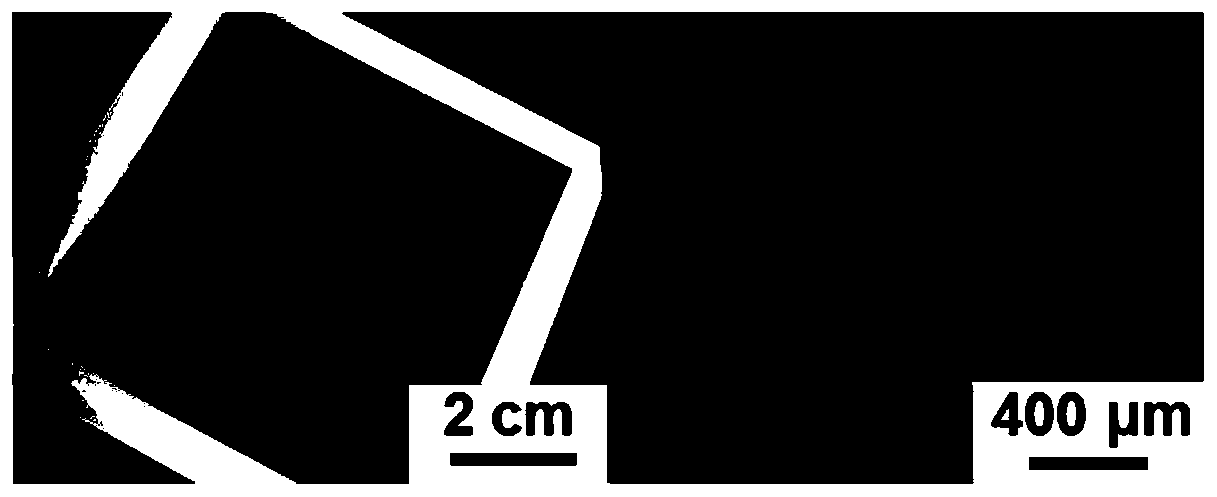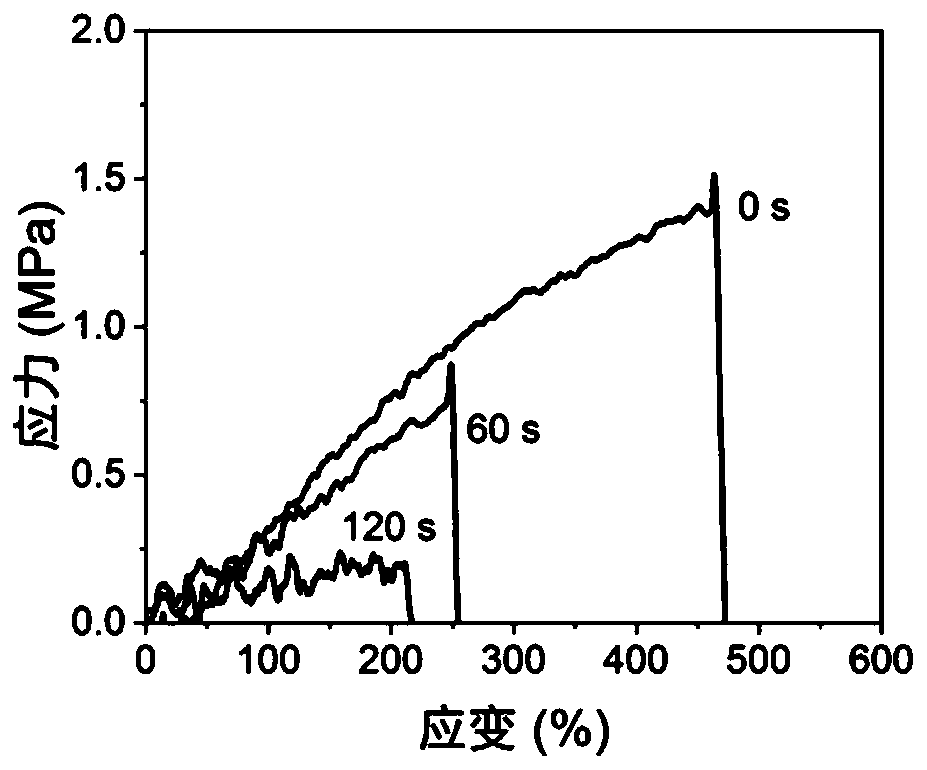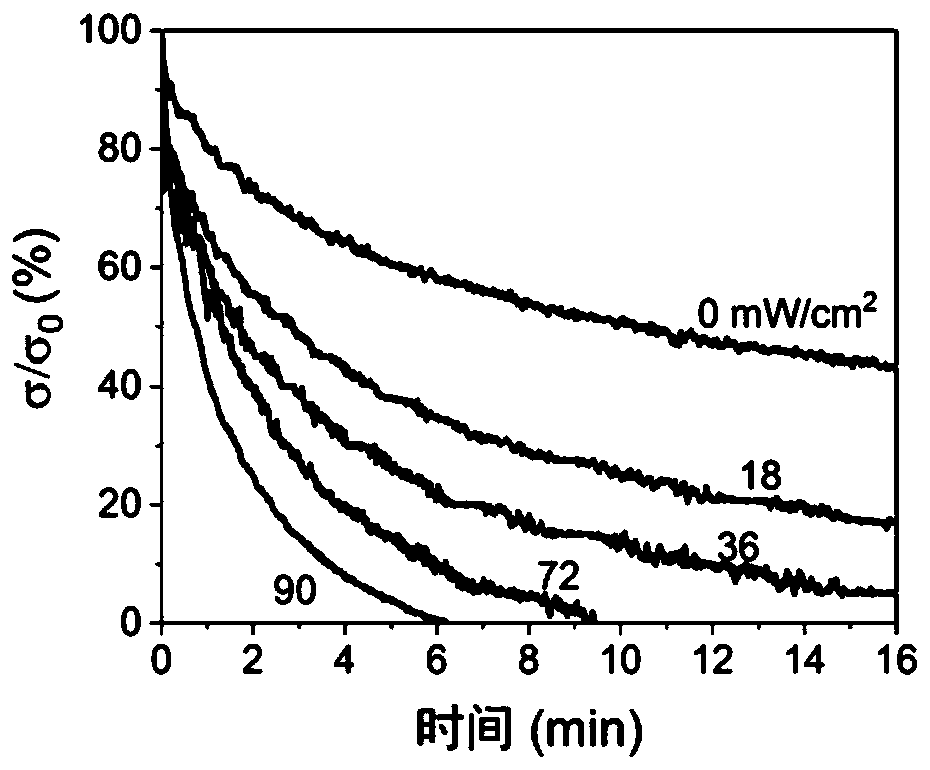Light-responsive and anti-freezing elastic gel fiber and preparation method thereof
An elastic gel and fiber technology, which is applied in fiber treatment, fiber chemical characteristics, spinning solution preparation, etc., can solve the problem that the fiber cannot have both photoresponsiveness, frost resistance, elasticity, high energy consumption of gel fiber, and preparation The complex process and other problems can be achieved to improve the mechanical properties, the preparation method is simple, and the modulus can be adjusted.
- Summary
- Abstract
- Description
- Claims
- Application Information
AI Technical Summary
Problems solved by technology
Method used
Image
Examples
Embodiment 1
[0034] Configure a mixed solvent of 2g glycerin (purchased from Sigma, the article number is V900122) and water, wherein the glycerol content is 20wt%, and add 0.5g of ferrous chloride (purchased from McLean, the article number is 1811897) and 0.25 g of citric acid (purchased from Sigma, product number is 791725), after completely dissolving, add 1g of acrylamide-sodium acrylate copolymer (molar mass is about 450,000g / mol, wherein acrylamide content is 75wt%) powder (purchased from Sigma company, article number is 511471), stir evenly, take the above mixed solution with a syringe, let it stand, and carry out microfluid spinning after the air bubbles are eliminated (environmental temperature: 25 ℃; ambient humidity: 30%; syringe pump extrusion speed: 10 μ L / min; receiver rotation speed: 5rpm) to obtain fibers, which can be further oxidized in the air to obtain photoresponsive and antifreeze elastic gel fibers. Regularly arranged fiber arrays and fiber nets can also be obtained...
Embodiment 2
[0042] Configure the mixed solvent of 3g glycerin and water, wherein glycerin content is 20wt%, in solvent, add the ferrous chloride of 0.45g and the citric acid of 0.25g, add the acrylamide-sodium acrylate copolymer (moles of 1.3g after dissolving completely The mass is about 450,000g / mol, wherein the content of acrylamide is 80wt%) and the powder is stirred evenly, and the above mixed solution is taken with a syringe, and left to stand, and microfluidic spinning is performed after the air bubbles are eliminated (ambient temperature: 25°C; ambient humidity: 30 %; syringe pump extrusion speed: 10 μ L / min; receiver rotation speed: 5 rpm) to obtain fibers, and the fibers can be further oxidized in the air to obtain photoresponsive and antifreeze elastic gel fibers. Regularly arranged fiber arrays and fiber nets can also be obtained by using the horizontal and uniform movement of the quadrilateral frame receiver.
Embodiment 3
[0044] Configure the mixed solvent of 2g glycerin and water, wherein glycerin content is 30wt%, in solvent, add the ferrous chloride of 0.5g and the citric acid of 0.35g, add the acrylamide-sodium acrylate copolymer (moles) of 0.8g after dissolving completely The mass is about 450,000g / mol, wherein the acrylamide content is 85wt%) powder is stirred evenly, and the above-mentioned mixed solution is taken with a syringe, and left to stand, and microfluidic spinning is performed after the air bubbles are eliminated (ambient temperature: 22°C; ambient humidity: 30 %; syringe pump extrusion speed: 10 μ L / min; receiver rotation speed: 5 rpm) to obtain fibers, and the fibers can be further oxidized in the air to obtain photoresponsive and antifreeze elastic gel fibers. Regularly arranged fiber arrays and fiber nets can also be obtained by using the horizontal and uniform movement of the quadrilateral frame receiver.
PUM
| Property | Measurement | Unit |
|---|---|---|
| Molar mass | aaaaa | aaaaa |
Abstract
Description
Claims
Application Information
 Login to View More
Login to View More - R&D
- Intellectual Property
- Life Sciences
- Materials
- Tech Scout
- Unparalleled Data Quality
- Higher Quality Content
- 60% Fewer Hallucinations
Browse by: Latest US Patents, China's latest patents, Technical Efficacy Thesaurus, Application Domain, Technology Topic, Popular Technical Reports.
© 2025 PatSnap. All rights reserved.Legal|Privacy policy|Modern Slavery Act Transparency Statement|Sitemap|About US| Contact US: help@patsnap.com



